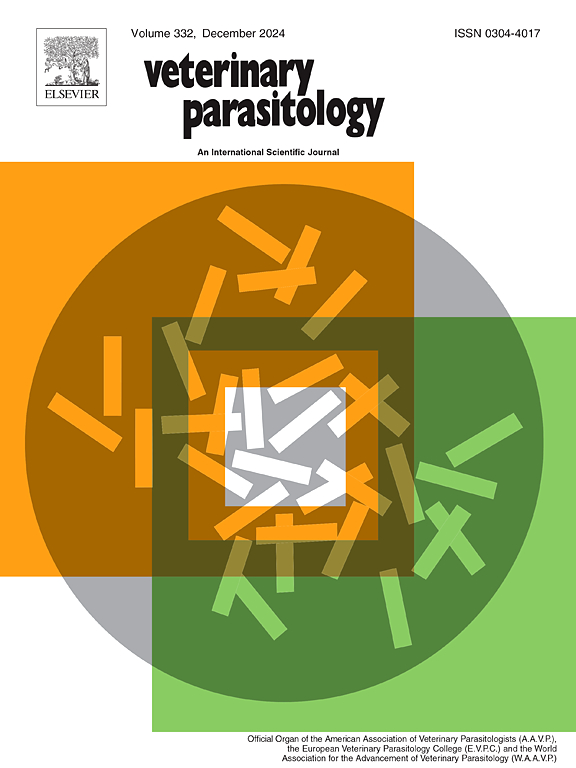牛的肌炎管理:用依普诺菌素外用溶液治疗对性能、行为改变以及肾上腺和全身对ACTH的反应的影响
IF 2
2区 农林科学
Q2 PARASITOLOGY
引用次数: 0
摘要
牛疥疮病可引起严重的瘙痒和皮肤病,损害动物的健康和福利,损害动物生产力,并进一步引起人畜共患问题。本研究通过行为指标和肾上腺反应性测试来评估肌癣病有效治疗对动物生产性能和福利的影响。16头诱发性疥疮病的小牛根据体重按限制随机分组,在第0天分为未治疗组(对照组)和治疗组(依普诺菌素5 mg/mL外用溶液[EPRINEX®pon]),并在治疗后监测8周(螨数、病变评分、抗疥疮抗体、采食量、体重、24小时行为录像、第58天促肾上腺皮质激素[ACTH]刺激)。治疗后4周,接受治疗的动物呈螨虫阴性,而所有未经治疗的牛仍有螨虫感染。抗体水平随螨计数和病变评分而变化,在治疗后下降,而在未治疗的对照组中上升。治疗后8周,治疗组体重增加较多(分别为81.9 kg和67.8 kg);P <; 0.05),并具有较高的饲料转化率(分别为0.203 kg增重/kg饲料和0.154 kg增重/kg饲料);p & lt; 0.01)。第0天,两组牛的行为活动无显著差异。然而,在第56天,与未处理的牛相比,处理过的牛在24 小时内花费了更多的时间躺在床上(p = 0.0754),并且摩擦、踢和舔的次数较少(p <; 0.05)。对各组第0天和第56天的行为分析显示,未治疗组的任何活动均无显著差异,但在8周前治疗的动物中,观察到躺卧时间延长,摩擦,踢踢和舔舐减少(p <; 0.05)。ACTH刺激表明未经治疗的牛肾上腺和全身反应性降低。通过对病畜管理的有效处理,使牛的生产性能大幅提高,有效缓解了管理带来的不良福利。对特定行为活动和肾上腺反应性测试的分析提供了证据,表明由管理虫感染引起的慢性应激可通过有效治疗预防不良福利和影响代谢能力。本文章由计算机程序翻译,如有差异,请以英文原文为准。
Sarcoptic mange in cattle: Effects of treatment with eprinomectin topical solution on performance, behavior changes, and adrenal and systemic responses to ACTH challenge
Bovine sarcoptic mange can cause significant pruritus and skin disease which compromise the health and welfare of the animals, impairs animal productivity and is furthermore of zoonotic concern. This study was conducted to evaluate the effects of efficacious treatment of sarcoptic mange on performance and on animal welfare using behavioral indicators and adrenal reactivity testing.
Sixteen young cattle with induced sarcoptic mange were allocated by restricted randomization based on body weight to an untreated group (control) or a treated group (eprinomectin 5 mg/mL topical solution [EPRINEX® Pour-On] at Day 0) and monitored for eight weeks after treatment administration (mite counts, lesion scores, anti-Sarcoptes antibodies, feed intake, body weight, 24-hour behavior videotaping, adrenocorticotropic hormone [ACTH] stimulation at Day 58).
The treated animals became mite-negative four weeks after treatment while all untreated cattle maintained the infestation. The antibody levels followed the mite counts and lesion scores, decreased after treatment in the treated cattle and increased throughout the study in the untreated controls. Over the 8-week post-treatment period, the treated animals gained more weight (81.9 kg vs. 67.8 kg, respectively; p < 0.05) and had a higher feed conversion efficacy (0.203 kg gain/kg feed vs. 0.154 kg gain/kg feed, respectively; p < 0.01). Behavioral activities of the cattle did not differ between the two groups at Day 0. However, at Day 56 treated cattle spent more time lying during 24 hours (p = 0.0754) and did less often rub, kick and lick (p < 0.05) than the untreated cattle. Analysis of the behaviors of Day 0 vs. Day 56 within each group demonstrated no significant difference for any activity in the untreated group, but extension of lying time and reduction of rubbing, kicking and licking (p < 0.05) were observed for the animals treated eight weeks before. The ACTH stimulation indicated reduced adrenal and systemic reactivity in the untreated cattle.
The efficacious treatment of sarcoptic mange resulted in a substantial increase of the performance of the cattle and effectively alleviated the adverse welfare caused by mange. Analysis of specific behavioral activities and adrenal reactivity testing provided evidence for adverse welfare and impacted metabolic capability due to chronic stress caused by the infestation with mange that can be prevented by efficacious treatment.
求助全文
通过发布文献求助,成功后即可免费获取论文全文。
去求助
来源期刊

Veterinary parasitology
农林科学-寄生虫学
CiteScore
5.30
自引率
7.70%
发文量
126
审稿时长
36 days
期刊介绍:
The journal Veterinary Parasitology has an open access mirror journal,Veterinary Parasitology: X, sharing the same aims and scope, editorial team, submission system and rigorous peer review.
This journal is concerned with those aspects of helminthology, protozoology and entomology which are of interest to animal health investigators, veterinary practitioners and others with a special interest in parasitology. Papers of the highest quality dealing with all aspects of disease prevention, pathology, treatment, epidemiology, and control of parasites in all domesticated animals, fall within the scope of the journal. Papers of geographically limited (local) interest which are not of interest to an international audience will not be accepted. Authors who submit papers based on local data will need to indicate why their paper is relevant to a broader readership.
Parasitological studies on laboratory animals fall within the scope of the journal only if they provide a reasonably close model of a disease of domestic animals. Additionally the journal will consider papers relating to wildlife species where they may act as disease reservoirs to domestic animals, or as a zoonotic reservoir. Case studies considered to be unique or of specific interest to the journal, will also be considered on occasions at the Editors'' discretion. Papers dealing exclusively with the taxonomy of parasites do not fall within the scope of the journal.
 求助内容:
求助内容: 应助结果提醒方式:
应助结果提醒方式:


